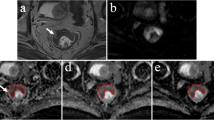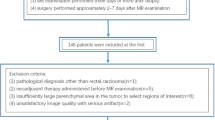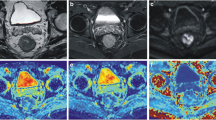Abstract
Objectives
Our goal was to investigate the correlation between histopathology and diffusion parameters by utilising the most repeatable region-of-interest (ROI) strategy for diffusion parameters in rectal cancer on a 3T scanner.
Methods
113 patients underwent DKI-MR and 66 of these patients received surgery without neoadjuvant chemoradiotherapy. Two readers independently measured the parameters using three slice protocols including single slice, three slices and whole-tumour slice (WTS), combined with one of two ROIs, including outline and round ROI. ANOVA, Kruskal-Wallis, a paired sample t-test, interclass correlation coefficient (ICC), Bland-Altman, Student’s t-tests, receiver operating characteristic curves and z statistic were used for statistical analysis.
Results
There were no significant differences among the three slice protocols in ADC values (p = 0.822, 0.987), K values (p = 0.842, 0.859) and D values (p = 0.917, 0.988) using round and outline ROI, respectively. The ADC and D values derived from outline ROIs were higher than those from round ROIs (all p < 0.001 for ADC, all p < 0.001 for D), while K values derived from outline ROIs were lower than those from round ROIs (p < 0.001, p = 0.001, p < 0.001) using three slice protocols, respectively. The WTS-outline ROI resulted in the best intra- and inter-observer ICC. Utilising the WTS-outline ROI method, the AUC for assessment of well-differentiated tumours was 0.871 by K and 0.809 by ADC; and the AUC for T2 was 0.768 by K.
Conclusions
The most repeatable strategy was the WTS-outline ROI method. In addition to DWI, DKI also have diagnostic value for rectal cancer histopathological characteristics utilising the WTS-outline ROI on a 3T scanner.
Key Points
• DKI using a 3T scanner is feasible for assessing rectal cancer.
• ROI and slice protocol show considerable influence on DKI parameters.
• DKI parameters exhibit excellent repeatability using whole-tumour slice-outline ROI on 3T scanner.
• DKI has considerable diagnostic value for the estimation of rectal cancer characteristics.





Similar content being viewed by others
Abbreviations
- ADC:
-
Apparent diffusion coefficient
- AJCC:
-
American Joint Committee on Cancer
- AUC:
-
Area under curve
- BA-LA:
-
Bland-Altman limits of agreements
- CRM:
-
Circumferential resection margin
- D:
-
Corrected diffusion coefficient
- DKI:
-
Diffusion kurtosis imaging
- DWI:
-
Diffusion weighted imaging
- EPI:
-
Single-shot echo-planar imaging
- ICC:
-
Interclass correlation coefficient
- K:
-
Diffusion kurtosis coefficient
- LVI:
-
Lymphovascular invasion
- MRI:
-
Magnetic resonance imaging
- NCRT:
-
Neoadjuvant chemoradiotherapy
- ROC:
-
Receiver operating characteristic
- ROI:
-
Region of interest
- SD:
-
Standard deviation
- SNR:
-
Signal-to-noise ratio
- SS:
-
Single slice
- T2WI:
-
T2-weighted images
- TS:
-
Three slices
- TSE:
-
Turbo spin echo
- WHO:
-
World Health Organization
- WTS:
-
Whole tumour slice
References
Van Cauter S, Veraart J, Sijbers J et al (2012) Gliomas: diffusion kurtosis MR imaging in grading. Radiology 263:492–501
Rosenkrantz AB, Sigmund EE, Johnson G et al (2012) Prostate cancer: feasibility and preliminary experience of a diffusional kurtosis model for detection and assessment of aggressiveness of peripheral zone cancer. Radiology 264:126–135
Rosenkrantz AB, Sigmund EE, Winnick A et al (2012) Assessment of hepatocellular carcinoma using apparent diffusion coefficient and diffusion kurtosis indices: preliminary experience in fresh liver explants. Magn Reson Imaging 30:1534–1540
Yu J, Xu Q, Song JC et al (2017) The value of diffusion kurtosis magnetic resonance imaging for assessing treatment response of neoadjuvant chemoradiotherapy in locally advanced rectal cancer. Eur Radiol 27:1848–1857
Hu F, Tang W, Sun Y et al (2017) The value of diffusion kurtosis imaging in assessing pathological complete response to neoadjuvant chemoradiation therapy in rectal cancer: a comparison with conventional diffusion-weighted imaging. Oncotarget. https://doi.org/10.18632/oncotarget.17491
Zhu L, Pan Z, Ma Q et al (2017) Diffusion Kurtosis Imaging Study of Rectal Adenocarcinoma Associated with Histopathologic Prognostic Factors: Preliminary Findings. Radiology 284:66–76
Lambregts DM, Beets GL, Maas M et al (2011) Tumour ADC measurements in rectal cancer: effect of ROI methods on ADC values and interobserver variability. Eur Radiol 21:2567–2574
Chao M, Guo X, Li L et al (2017) Effect of region of interest size on ADC measurements in pancreatic adenocarcinoma. Cancer Imaging 17:13
Colagrande S, Pasquinelli F, Mazzoni LN, Belli G, Virgili G (2010) MR-diffusion weighted imaging of healthy liver parenchyma: repeatability and reproducibility of apparent diffusion coefficient measurement. J Magn Reson Imaging 31:912–920
Bickel H, Pinker K, Polanec S et al (2017) Diffusion-weighted imaging of breast lesions: Region-of-interest placement and different ADC parameters influence apparent diffusion coefficient values. Eur Radiol 27:1883–1892
Sun K, Chen X, Chai W et al (2015) Breast cancer: diffusion kurtosis mr imaging—diagnostic accuracy and correlation with clinical-pathologic factors. Radiology 277:46–55
Jensen JH, Helpern JA (2010) MRI quantification of non-Gaussian water diffusion by kurtosis analysis. NMR Biomed 23:698–710
Jensen JH, Helpern JA, Ramani A, Lu H, Kaczynski K (2005) Diffusional kurtosis imaging: The quantification of non-gaussian water diffusion by means of magnetic resonance imaging. Magn Reson Med 53:1432–1440
Edge SB, Compton CC (2010) The American Joint Committee on Cancer: the 7th edition of the AJCC cancer staging manual and the future of TNM. Ann Surg Oncol 17:1471–1474
Inoue C, Fujii S, Kaneda S et al (2014) Apparent diffusion coefficient (ADC) measurement in endometrial carcinoma: effect of region of interest methods on ADC values. J Magn Reson Imaging JMRI 40:157–161
Akashi M, Nakahusa Y, Yakabe T et al (2014) Assessment of aggressiveness of rectal cancer using 3-T MRI: correlation between the apparent diffusion coefficient as a potential imaging biomarker and histologic prognostic factors. Acta Radiol 55:524–531
Curvo-Semedo L, Lambregts DM, Maas M et al (2012) Diffusion-weighted MRI in rectal cancer: Apparent diffusion coefficient as a potential noninvasive marker of tumor aggressiveness. J Magn Reson Imaging 35:1365–1371
Sun Y, Tong T, Cai S et al (2014) Apparent Diffusion Coefficient (ADC) Value: A Potential Imaging Biomarker That Reflects the Biological Features of Rectal Cancer. PloS One 9:e109371
Wu EX, Cheung MM (2010) MR diffusion kurtosis imaging for neural tissue characterisation. NMR Biomed 23:836–848
Funding
This study has received funding by the National Natural Science Foundation of China (Grant No. 81501437).
Author information
Authors and Affiliations
Corresponding authors
Ethics declarations
Guarantor
The scientific guarantor of this publication is Yajia Gu.
Conflict of interest
The authors of this manuscript declare relationships with the following companies: Siemens Shenzhen Magnetic Resonance Ltd., Shenzhen, China and MR Collaboration NE Asia, Siemens Healthineers, Shanghai, China
Statistics and biometry
Huixun Jia, MD, Department of Clinical Statistics Center, Fudan University Shanghai Cancer Center; Department of Oncology, Shanghai Medical College, Fudan University, Shanghai, China kindly provided statistical advice for this manuscript.
Informed consent
This was a retrospective study and did not require informed consent.
Ethical approval
Institutional Review Board approval was obtained.
Methodology
• retrospective
• diagnostic or prognostic study
• performed at one institution
Rights and permissions
About this article
Cite this article
Sun, Y., Xiao, Q., Hu, F. et al. Diffusion kurtosis imaging in the characterisation of rectal cancer: utilizing the most repeatable region-of-interest strategy for diffusion parameters on a 3T scanner. Eur Radiol 28, 5211–5220 (2018). https://doi.org/10.1007/s00330-018-5495-y
Received:
Revised:
Accepted:
Published:
Issue Date:
DOI: https://doi.org/10.1007/s00330-018-5495-y




